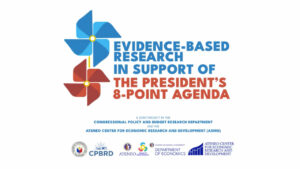WB cuts PHL growth outlook to 5.4%

By Luisa Maria Jacinta C. Jocson, Reporter
PHILIPPINE economic growth would probably slow to 5.4% this year, from an estimated 7.2% in 2022, amid a looming global recession, the World Bank (WB) said.
In its latest Global Economic Prospects report, it trimmed its gross domestic product (GDP) growth forecast for the Philippines from its 5.6% projection in June.
The World Bank’s latest GDP forecast is below the government’s 6-7% growth target for the year.
“After the strong rebound in 2022, growth in Malaysia, the Philippines and Vietnam is expected to moderate as the growth of exports to major markets slows,” it said.
In December, the World Bank upgraded its forecast for the Philippines to 7.2% for 2022 from 6.5%, amid a surge in private consumption and robust export growth.
The Philippine economy expanded by 7.6% in the third quarter, bringing the nine-month average to 7.7%. The strong third-quarter data prompted economic managers to say that full-year GDP growth would settle above the 6.5-7.5% target.
“The recovery from the pandemic-induced recession has been uneven across the region. Output surpassed pre-pandemic levels last year in Cambodia, the Philippines and Thailand,” the World Bank said.
However, a “sharp, long-lasting” slowdown in the global economy this year is expected to affect nearly all regions, particularly developing countries, World Bank President David Malpass said in a statement.
“Global growth is expected to decelerate sharply to 1.7% in 2023 — the third weakest pace of growth in nearly three decades, overshadowed only by the global recessions caused by the pandemic and the global financial crisis,” the multilateral lender said in the report, noting this is 1.3 percentage points below previous forecasts.
The World Bank said the latest estimate reflects “synchronous policy tightening aimed at containing very high inflation, worsening financial conditions and continued disruptions from Russia’s invasion of Ukraine.”
It said urgent global efforts are needed to mitigate the risks of a global recession and debt distress in emerging market and developing economies.
By the end of 2024, GDP levels in these markets will be about 6% below pre-pandemic levels, according to the report.
Mr. Malpass said emerging markets and developing economies would likely face a multi-year period of slow growth due to weak investment “as global capital is absorbed by advanced economies to meet extremely high government debt levels and rising interest rates — and also heavy debt burdens.”
The World Bank raised the Philippines’ GDP forecast to 5.9% for 2024 from 5.6%.
REGIONAL OUTLOOKBased on the World Bank report, the Philippines’ 5.4% GDP growth is expected to be the second-fastest in Southeast Asia this year, behind Vietnam’s 6.3%.
The East Asia and Pacific region is expected to grow by 4.3% this year, amid China’s anticipated economic recovery. This is lower than the previous projection of over 5% for 2023 and 2024.
“The downward revisions are broad-based and reflect COVID-19-related disruptions and protracted weakness in the real estate sector in China and weaker-than-expected goods export growth across the region,” it said. “In the face of ongoing monetary tightening, moderating activity, easing supply chain disruptions and lower prices for many commodities, inflation is expected to ease somewhat after peaking in 2022.”
Excluding China, the region’s growth is expected to moderate to 4.7% in 2023 and 2024 “as pent-up demand dissipates and declining goods export growth outweighs belated recovery in tourism and travel,” the World Bank said.
Governments can curb the impact of a potential global recession by boosting investments to create jobs and increase output, improve the business environment and promote greater debt transparency and sustainability, it added.
It also cited the importance of integrating climate and development to increase energy access and speed up the transition to lower-carbon energy, and emphasized the need for stronger increased cross-border trade.
FMIC FORECASTMeanwhile, First Metro Investment Corp. (FMIC) said the Philippine economy is expected to expand by 6% this year.
“This year, we continue to anticipate external headwinds, slower global growth, interest rates and inflation will remain elevated and volatility will persist which will temper growth. In the face of all this, the economy will remain resilient and is expected to expand by 6%,” FMIC President Jose Patricio A. Dumlao said at a virtual briefing on Wednesday.
Victor A. Abola, an economist at University of Asia and the Pacific (UA&P), said the economy will face challenges from the impact of the Russia-Ukraine war, the global economic recession, rising interest rates and elevated inflation.
“A combination of the slowdown and rising interest rates have created uncertainties that lingers on,” he said.
Mr. Abola said easing crude oil prices and lower wheat and industrial commodity prices will help temper rising inflation.
“In the Philippine economy, we see more light in domestic demand-driven growth, fiscal space, infrastructure and house spending, and consumer spending,” he said.
“An important point that characterizes our economy is we are largely driven by domestic demand, meaning we are less exposed to fluctuations in the global market.”
Mr. Abola said increased investments in infrastructure and bullish consumer spending will help boost growth this year.




